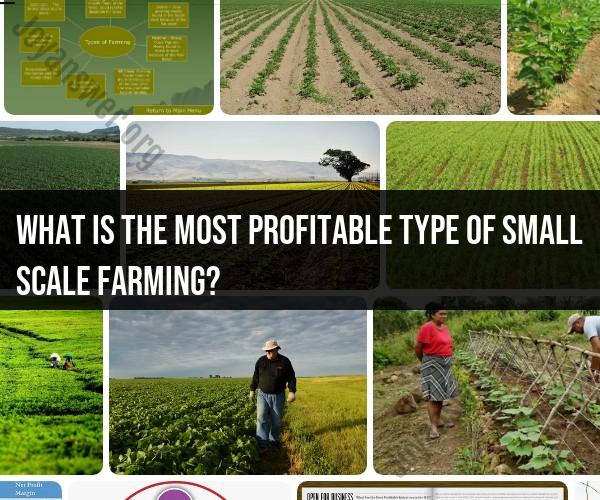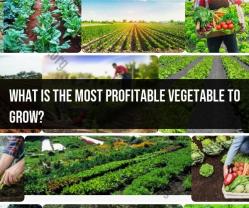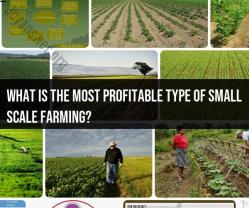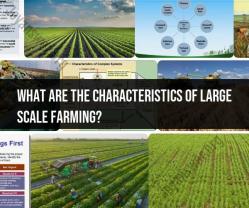What is the most profitable type of small scale farming?
The profitability of small-scale farming depends on various factors, including location, climate, soil quality, market demand, and the skills and resources of the farmer. What may be the most profitable type of small-scale farming in one area may not be the same in another. Here are some profitable types of small-scale farming and strategies to consider:
Market Gardening:
- Growing high-value crops like specialty vegetables, herbs, or salad greens for local markets, restaurants, and farmers' markets.
- Using intensive planting methods, such as raised beds or container gardening, to maximize yields in small spaces.
Microgreens and Specialty Herbs:
- Cultivating microgreens and specialty herbs, which are in high demand by chefs and health-conscious consumers.
- Microgreens have a quick turnaround time and can be grown in limited space.
Organic Farming:
- Focusing on organic farming practices, which can command higher prices in organic markets.
- Meeting organic certification requirements to access premium markets.
Mushroom Farming:
- Growing gourmet or medicinal mushrooms, such as shiitake, oyster, or reishi, which have a growing market.
- Utilizing small spaces, like basements or garages, for mushroom cultivation.
Flower Farming:
- Cultivating specialty cut flowers or ornamental plants for local florists, wedding events, and farmers' markets.
- Offering unique and seasonal blooms can be profitable.
Urban Farming:
- Utilizing urban spaces, rooftops, or vacant lots for small-scale farming to cater to local urban markets.
- Selling directly to urban consumers or restaurants.
Goat Farming:
- Raising goats for meat, dairy, or fiber production. Goat products are in demand among certain demographics.
- Offering value-added products like goat cheese or soap can increase profitability.
Beekeeping:
- Maintaining beehives and harvesting honey, beeswax, and other bee-related products.
- Providing pollination services to local farms can be an additional income source.
Aquaponics and Hydroponics:
- Employing soilless farming methods like aquaponics (combining fish farming with hydroponics) or hydroponics (growing plants in nutrient-rich water) to maximize yields in small spaces.
- Producing high-value crops like lettuce, herbs, or fish in controlled environments.
Pastured Poultry:
- Raising pastured chickens, ducks, or turkeys for meat and eggs.
- Emphasizing humane and sustainable practices to appeal to consumers seeking ethically raised poultry.
Value-Added Products:
- Creating value-added products from your farm produce, such as jams, sauces, pickles, or preserves.
- Marketing these products at local farmers' markets or through online sales.
Agroforestry:
- Integrating trees, shrubs, or perennial crops with traditional farming to diversify income sources.
- Agroforestry practices like growing fruit trees, nut orchards, or timber can provide long-term profits.
The most profitable type of small-scale farming for you will depend on your local market demand, available resources, and your skills and interests. Conduct thorough market research and consider experimenting with different crops or methods to determine what works best for your specific situation. Additionally, building relationships with local consumers, chefs, and market outlets can enhance the profitability of your small-scale farm.
Small-Scale Farming: Exploring Profitable Avenues for Agricultural Success
Small-scale farming is a great way to get into agriculture, especially if you have limited land or resources. There are many profitable ventures that small-scale farmers can pursue, including:
- Growing specialty crops: Specialty crops are high-value crops that are not typically grown on large farms. Some examples of specialty crops include microgreens, herbs, heirloom tomatoes, and specialty mushrooms. Specialty crops can be sold to farmers markets, restaurants, and grocery stores.
- Raising livestock: Small-scale farmers can also raise livestock for profit. Some popular livestock for small-scale farms include chickens, goats, sheep, and rabbits. Livestock products such as eggs, meat, milk, and cheese can be sold to consumers or to restaurants.
- Offering value-added products: Value-added products are agricultural products that have been processed or transformed in some way. For example, a small-scale farmer could make jam from their own fruit, or cheese from their own goat's milk. Value-added products can be sold at a higher price than raw agricultural products.
- Providing agritourism experiences: Agritourism is a type of tourism that involves visiting and participating in agricultural activities. Small-scale farmers can offer agritourism experiences such as farm tours, farm-to-table dinners, and educational programs.
Finding Your Niche: Profitable Ventures in Small-Scale Farming
The best way to find a profitable venture for your small-scale farm is to consider your interests, skills, and resources. You should also consider the climate and soil conditions in your area.
If you are not sure what kind of venture is right for you, there are a few things you can do to research your options:
- Talk to other small-scale farmers in your area. They can give you advice on what crops and livestock are successful in your area, and how to market your products.
- Visit farmers markets and talk to the vendors. This can give you an idea of what kinds of products are in demand and what prices you can charge.
- Take a small-scale farming class or workshop. This can teach you the basics of farming and help you to develop a business plan.
Once you have chosen a venture, you need to develop a business plan. This will help you to set goals, track your progress, and make sure that your venture is profitable.
Sustainable and Lucrative: Strategies for Profitable Small-Scale Farming
There are a number of things that small-scale farmers can do to ensure that their ventures are sustainable and lucrative. Some important strategies include:
- Diversifying your crops and livestock: This can help to reduce your risk if one crop or livestock fails.
- Using sustainable farming practices: Sustainable farming practices can help to improve soil health, reduce water usage, and decrease pests and diseases.
- Marketing your products effectively: It is important to develop a marketing plan to reach your target customers.
- Managing your finances carefully: It is important to track your income and expenses so that you can make sure that your venture is profitable.
Small-scale farming can be a rewarding and profitable way to make a living. By following the strategies above, small-scale farmers can increase their chances of success.








